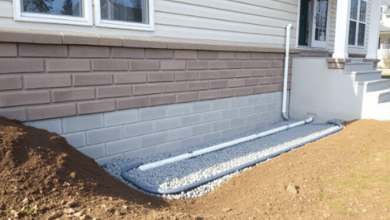
When was the last time you checked on your house—not your Wi-Fi signal or fire extinguisher—but the structure itself? We build plans for disasters, prep kits for outages, and test alarms every season. But very few people stop to ask if their walls, windows, and roof are actually ready to handle a storm, a deep freeze, or a sudden shift in weather. That’s the part of safety that often goes unnoticed: the physical framework that’s supposed to protect everything else.
Across the U.S., homes are being tested more frequently by the unexpected. Wild storms in spring. Drought and heat in summer. Ice in fall before leaves even finish changing. While attention usually focuses on cleanup and insurance, smart homeowners are now looking at prevention—starting with what holds their home together.
In colder climates like Syracuse NY, where snow loads are serious and winters stretch long, weather can wear down a home faster than you expect. If the bones of the house aren’t solid, no amount of planning will protect you when the pressure hits. In this blog, we will share why structural check-ins should be part of every home safety plan, and how a few strategic updates can keep both your space and your peace of mind intact.
Where Most Safety Plans Fall Short
Most safety plans assume the structure itself is stable. That assumption doesn’t always hold up. Many homeowners in upstate regions are already taking a second look.
After seeing how fast one winter storm can overwhelm older homes, more people are turning to reliable companies that specialize in window replacement in Syracuse NY to help prepare their properties ahead of time. Why? Because windows are one of the most common failure points during severe weather—and one of the most overlooked.
Outdated windows allow drafts, moisture, and mold to settle in quietly. When the temperature drops, they leak heat. When snow piles up, frames warp. And when insulation fails, your energy bills skyrocket. Replacing weak windows isn’t just an energy decision. It’s a safety one. Structurally sound, sealed, and weather-rated windows give your home a layer of protection that’s active year-round, even when you aren’t thinking about it.
What Small Signs Are Trying to Tell You
Homes have a way of whispering problems before they shout. The trick is paying attention.
Doors that suddenly don’t close right. Windows that fog between the panes. A draft near your feet even when the heat’s running. These aren’t just quirks. They’re your home telling you something’s shifting.
Water damage is another silent enemy. Even a small leak from an unsealed window can rot the wood around it, create hidden mold, or compromise insulation. Over time, these small areas of decay weaken walls, ceilings, and supports. And when the structure gets soft, your entire home is more vulnerable during high winds or pressure shifts.
A seasonal check-in can help catch these issues early. Before winter or summer, walk your home. Look at all entry points. Check walls and ceilings for moisture spots. Feel for cold air near baseboards and corners. And if something feels off, don’t wait. Quick fixes today can save you from bigger emergencies tomorrow.
More Than Just Protection—It’s Prevention
Safety isn’t just about what happens after a storm. It’s about the condition your home is in before it arrives. A structurally sound home stays warmer, drier, and quieter. It handles stress better. It keeps your family safer without you needing to flip a switch.
This goes beyond windows. Roof integrity. Siding that doesn’t buckle under snow. Seals that actually seal. These things don’t get attention until they fail. But when they hold up, you barely notice them—and that’s the point.
For example, if your home is losing heat through warped windows or cracked frames, your furnace works harder. That extra load not only raises your bill, but increases the risk of system failure in the cold. And if you rely on electric heat, it could even become a health risk during an outage.
Prevention means investing in parts of the home that often go ignored. The upgrades you make today may never show up in an emergency report—but they’ll be the reason you stay safe during one.
Why Seasons Quietly Reveal What Structure Tries to Hide
Seasons have a way of exposing what’s been ignored. In the summer, heat creeps in through weak seals. In winter, cold air slices past aging frames. Spring floods test drainage systems. Fall wind finds every drafty corner. Most of us chalk these up to weather changes, but they often signal deeper problems in your home’s structure.
Lifestyle habits also shift with the seasons. Maybe you host more in the summer, cook more in the winter, or start using spaces differently when kids are back in school. These subtle routine changes place different kinds of pressure on your home—and often reveal flaws you didn’t see coming. A cracked sill that seemed minor in July can become a real threat in January. These aren’t just seasonal annoyances. They’re warnings that your structure might not be keeping up with your life.
Resilience Comes from What You Can’t Always See
A well-prepped home should make you feel confident. You should be able to sit through a storm without wondering if your ceiling will leak or your heating will fail. That’s the level of resilience homeowners need to build now.
Why? Because weather is becoming more intense, less predictable, and faster moving. FEMA declared over 90 major disasters in the U.S. just last year. That’s almost two per week. And while we can’t stop the weather, we can absolutely strengthen the spaces we rely on.
Start with the structure. Build your safety plan around it, not on top of it. Check your windows. Check your roofline. Look at your doors, your siding, your insulation. These aren’t optional maintenance items. They are active systems in your home’s ability to protect and perform.
A house that stands up to pressure is worth more than one that just looks good in photos. It carries your routine, your belongings, and your people. So yes, plan your escape routes. Test your smoke detectors. But don’t forget to check the structure those plans depend on.
Because when it comes to safety, prevention always beats repair. And the strongest plans start where the trouble usually does—the outside edges of home.




